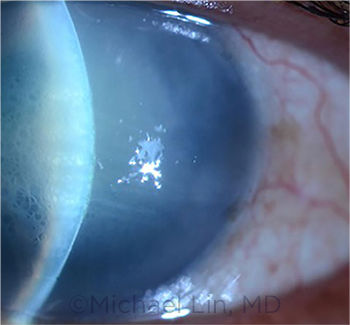Download PDF
Researchers at Massachusetts Eye and Ear (MEE) in Boston have added to a small but growing body of case reports in which patients developed reticular corneal epithelial edema following treatment with netarsudil (Rhopressa; Aerie).1 In keeping with earlier reports, all cases fully resolved after the patient discontinued the topical rho kinase inhibitor, which was approved by the FDA in 2017 for use as an IOP-lowering drug for patients with ocular hypertension and open-angle glaucoma.
This report is the first to provide photographic evidence of how the unique reticular honeycomb pattern of edema resolves over time, as individual bullae become smaller and more widely spaced apart.
 |
CORNEAL EDEMA. Reticular corneal epithelial edema in a patient with preexisting corneal haze. The edema developed shortly after the patient began treatment with netarsudil.
|
Retrospective results. All but one of eight cases of netarsudil-induced edema identified in the MEE database had corneal conditions or procedures that predisposed them to develop the edema, including penetrating keratoplasty (PK), corneal decompensation after trabeculectomy-associated endophthalmitis, and Fuchs endothelial corneal dystrophy undergoing Descemet stripping only.
Onset of most instances of the edema was within weeks after initiating netarsudil. However, the researchers also documented a previously unreported phenomenon in which two patients tolerated the medication for months but then developed the edema on post-op day 1 following diode laser cyclophotocoagulation. In another finding, anterior segment OCT imaging revealed that in eyes with a history of PK, reticular corneal epithelial edema affected both host and donor cornea simultaneously.
The chart review also revealed a paradoxical lowering of IOP after stopping netarsudil.
Clinical implications. The true rate of netarsudil-associated reticular epithelial edema is unknown, but the majority of patients who use netarsudil do not develop the condition, said Michael Lin, MD, and his coauthors.
In addition, although it is known that netarsudil lowers IOP by increasing aqueous outflow through the trabecular meshwork and decreasing episcleral venous pressure, the mechanism behind the development of reticular corneal epithelial edema in patients who use netarsudil remains unclear.
And the study has not significantly affected Dr. Lin’s decision to prescribe netarsudil for some glaucoma patients who need lower IOP, he said. “Unless patients have preexisting corneal issues, I am not especially concerned about them developing reticular corneal epithelial edema.”
Although insurance coverage initially limited netarsudil to use as a last resort, Dr. Lin said, some ophthalmologists are prescribing the drug earlier in selected cases of glaucoma. This is particularly true for those patients who have difficulty using other medications that require dosing multiple times per day, and for those whose glaucoma is believed to be primarily caused by trabecular meshwork dysfunction.
Advice to clinicians. Dr. Lin reexamines all patients after they’ve started netarsudil. He also counsels patients about potential conjunctival injection, which may occur with the medication.
He added, “Given the findings of this study and others, ophthalmologists may want to avoid netarsudil in patients with compromised corneas—although they could potentially still try the medication and then stop it if reticular corneal epithelial edema develops.”
For his part, Dr. Lin said, if he sees that a patient has developed the condition, “I’ll likely stop the netarsudil and expect full recovery.”
—Miriam Karmel
___________________________
1 Tran JA et al. Am J Ophthalmol Case Rep. Published online Jan 20, 2022.
___________________________
Relevant financial disclosures: Dr. Lin—None.
For full disclosures and the disclosure key, see below.
Full Financial Disclosures
Dr. Acharya NEI: S.
Dr. Ganguly None.
Dr. Lin None.
Dr. Patel AbbVie: C; Aerie: P; Emmecell: C; GlaxoSmithKline: C; Iris Medicine: P.
Disclosure Category
|
Code
|
Description
|
| Consultant/Advisor |
C |
Consultant fee, paid advisory boards, or fees for attending a meeting. |
| Employee |
E |
Hired to work for compensation or received a W2 from a company. |
| Employee, executive role |
EE |
Hired to work in an executive role for compensation or received a W2 from a company. |
| Owner of company |
EO |
Ownership or controlling interest in a company, other than stock. |
| Independent contractor |
I |
Contracted work, including contracted research. |
| Lecture fees/Speakers bureau |
L |
Lecture fees or honoraria, travel fees or reimbursements when speaking at the invitation of a commercial company. |
| Patents/Royalty |
P |
Beneficiary of patents and/or royalties for intellectual property. |
| Equity/Stock/Stock options holder, private corporation |
PS |
Equity ownership, stock and/or stock options in privately owned firms, excluding mutual funds. |
| Grant support |
S |
Grant support or other financial support from all sources, including research support from government agencies (e.g., NIH), foundations, device manufacturers, and\or pharmaceutical companies. Research funding should be disclosed by the principal or named investigator even if your institution receives the grant and manages the funds. |
| Equity/Stock/Stock options holder, public corporation |
US |
Equity ownership, stock and/or stock options in publicly traded firms, excluding mutual funds. |
|
More from this month’s News in Review